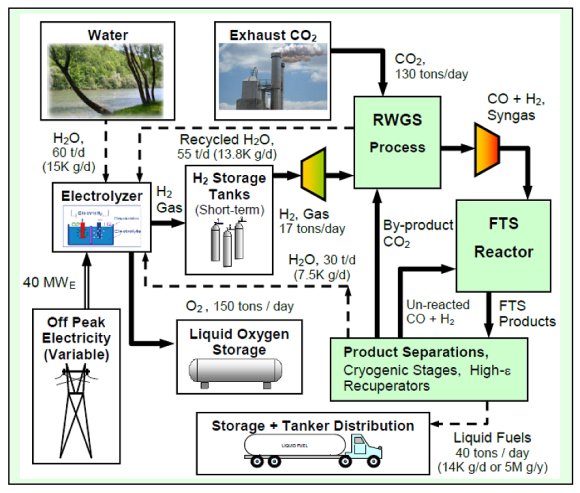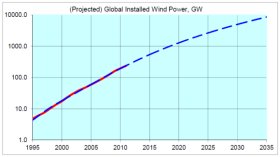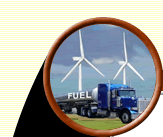 |
Updated 8/6/2012
WindFuels Overview
While almost no one noticed,
the economics for producing clean fuels and hydrocarbons
from
water, waste CO2, and wind energy improved
by a factor of ten between 2002 and 2008. Over the past
five years, we have
applied for patents on the scientific
and technological basis for another factor-of-two
improvement in the economics. We have shown that it will
be possible (as soon
as the plants can be built) to profitably produce high-purity
carbon-neutral
gasoline, jet fuel, alcohols, and
many other hydrocarbons in volumes that cannot be matched
by any other renewable avenue, from off-peak wind energy,
waste CO2,
and water.
Our breakthroughs permit production
of gasoline, diesel, and other fuels and chemicals from
waste CO2 and
water on wind farms at twice the efficiency that was
thought likely just three years ago.
WindFuels
Concept

• First,
water and renewable electrical power are fed into an electrolyzer,
which produces the hydrogen needed.
• Then
waste CO2 (from
coal power plants) and the renewable hydrogen are
piped into our novel Renewable Fischer-Tropsch Synthesis
(RFTS)
plant. There, they are converted into fuels and chemicals (including
gasoline, jet fuel, and diesel).
•
These fuels may then be readily stored and distributed by conventional
means – pipelines and tanker trucks.
• The electrolyzer also produces a huge amount of oxygen, which may
be sold if market conditions warrant, or it may be utilized
in novel processes to improve the efficiency of the RFTS plant.
• There has been steady progress in the development of Gas-to-Liquids
(GTL) processes for production of fuels and chemicals of
all types over the past
30
years.
Within
the
past 5 years, many of the needed advances have been demonstrated.
• We have pending patents and proprietary technology advancing the remaining
key technical pieces. Our RFTS process is compatible with variable renewable
energy
sources, particularly wind energy, for producing alcohols and hydrocarbons
from waste CO2 and water at
maximum practical efficiency.
• We show that WindFuels has numerous economical and environmental
advantages compared to all other renewable fuels that have
been proposed.
Wind energy is by far our
most competitive renewable energy resource. There is enough wind
energy (in class 4 sites and higher, mean wind speed above 16
mph) to
supply ten times the world’s current total electrical energy
usage. The perceived challenge is getting wind energy from good
sites to where and when it is needed, both for the transportation
sector and for the power grid. Efficient conversion of off-peak
wind energy into ultra-clean, stable, liquid fuels solves both
the energy storage problem
and the grid stability problem. In doing so, it allows wind energy
to continue to grow rapidly at least through the middle of this
century.
A Major Cut In CO2 emissions.
Many have said increased fuel efficiency
in the transportation sector is the greatest opportunity for reducing CO2 emissions.
However, even a very aggressive plan to that effect would reduce global CO2 emissions
by under 5% compared to expected market forces over the next three decades – partly
because cars have an average lifetime of over 17 years and because market forces
alone will lead to improved fuel mileages at about the maximum practical rate
of a few percent per year.
The only possibly viable option that has been on the table for dealing with
climate change is CO2 separation (capture) and sequestration (CCS).
Real-world experience over the past five years at several different sites suggests
the
cost for the
sequestration
alone – not including the cost of CO2 separation from the
exhaust of coal plants – will be at least $30/ton of CO2.
(A new DOE 1-million-ton sequestration demonstration project will cost $300/ton.)
There is also still
uncertainty about long-term stability and safety of CO2 sequestration
on the scale of 10,000 times the current experimental level. Several studies
have shown CCS is likely to stimulate earthquakes, and that much of the CO2
would leak out much faster than most have thought. In about 3 decades, WindFuels
will eliminate the need for CO2 sequestration by recycling
the CO2 from
power plants (we do agree that sequestration should be implemented at new
coal plants in the meantime).
Some might argue that WindFuels are not ideal because they don’t immediately
eliminate fossil CO2, but economic realities are also essential.
When WindFuels are burned, fossil CO2 is released at that point
into the atmosphere (assuming it was made using CO2 from fossil-fueled
power plants), but it has displaced the use of oil. We can use the CO2 from
coal plants as a tool to eliminate our use of petroleum and natural gas (which
together account for over 60% of
our CO2 emissions) on a timescale that cannot be matched by any
other option. At the same time, we will prevent coal-to-liquids from competing.
• WindFuels
eliminates the need for expensive CO2 sequestration
by recycling the CO2 from power plants.
• WindFuels will be cheaper than heavy-oil products or cellulosic
ethanol.
• WindFuels could be a one-trillion-dollar market in 18 years.
•
WindFuels is the “greenest” transportation fuel
solution yet proposed: Converting CO2 into
gasoline, ethanol, diesel, jet fuel, and plastics – by
the gigaton.
•
WindFuels will be competitive with petroleum within six years,
and WindFuels are scaleable globally in less than four
decades to the 10 TW level because they are 80% based on systems
currently
in commercial production at the multi-billion-dollar
level. Each terawatt of renewable power used in the advanced
RFTS process will
produce 4B bbl/yr of fuels and other high-value chemicals – which
would likely be worth over 1.5 trillion dollars per year
in less than 20 years.
|
 |
 

| |
|
| |
| For those that are not scientists,
or engineers or are not very familiar with
chemical engineering, we have a WindFuels
Primer to
help you get started. |
| |
How are WindFuels carbon neutral?
No new fossil carbon is required. WindFuels
use wind energy, waste CO2 (from coal power
plants), and water to make clean alcohols and other fuels. |
| |
| An average
acre of land in the Dakotas, Kansas, or Wyoming will produce
4 to 15 times as much
fuel from wind, water, and waste CO2 as an
average acre of land in fertile farming areas devoted to
biofuels – and
do it much more cost effectively and with less societal and
environmental impact |
| |
What is FTS?
Fischer-Tropsch Synthesis is a controlled chemical reaction involving carbon
monoxide (CO) and hydrogen (H2). The CO and H2 pass
through a catalyst at high temperature and pressure, which causes the gasses
to combine
to form
various
hydrocarbons. If you run
across the acronym “RFTS”, that’s merely an FTS process that
is fueled through renewable sources – so it’s a Renewable FTS process. |
| |
| The scalability
of liquid WindFuels over the next four decades exceeds that
of cellulosic ethanol by at least a
factor of 5, and there are no major adverse environmental
concerns. |
| |
| The
global growth rate in wind energy has averaged 22% for
the past 17 years. Converting the off-peak wind energy
(beyond that needed for the grid) to liquid fuels will
allow this
growth rate to continue unabated for another 20 years. |
| |

Installed global (peak) wind energy
projection based on a fourth-order fit to the data from the
past 17
years. |
| |
| $$$ CO2 sequestration will be at least $30/ton. (A new
DOE million ton sequestration demonstration project will
cost $300/ton.) $$$ |
| |
|
  |

